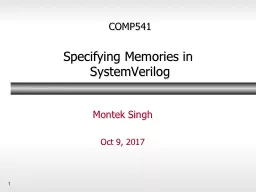

SystemVerilog Montek Singh Oct 9 2017 Overview of ROM and RAM 2 ReadOnly Memory ROM Memory that is permanent often the data is baked into during fabrication there are ROM flavors that allow updates ID: 651549
Download Presentation The PPT/PDF document "1 COMP541 Specifying Memories in" is the property of its rightful owner. Permission is granted to download and print the materials on this web site for personal, non-commercial use only, and to display it on your personal computer provided you do not modify the materials and that you retain all copyright notices contained in the materials. By downloading content from our website, you accept the terms of this agreement.
Slide1
1
COMP541Specifying Memories in SystemVerilog
Montek Singh
Oct 9, 2017Slide2
Overview of ROM and RAM2Slide3
Read-Only Memory (ROM)Memory that is ‘permanent’often the data is “baked into” during fabricationthere are ROM flavors that allow updatesPROM, EEPROM, etc.updates are typically infrequent or sporadicTop-level view:k address lines2k data locations
n bits of data at each location
3Slide4
Read-Write Memory (RAM)Allows reads and writes with similar speedscalled “random-access memory” (RAM)as opposed to spools of tape sequential accessTop-level view:k address lines2k data locationsn bits of data/locationdata input as well
Need a line to specify reading or writingtypically only one wire neededsometimes two separate ones
4Slide5
SystemVerilogBehavioral descriptions of:ROM, single-ported RAM, dual-ported RAM, etc.5Slide6
SystemVerilog: 1-port RAMRAM examplesingle-ported one address (for reading and writing)whether read or written is determined by “write enable”clockall writes take place on clock tickreads are asynchronousi.e., output after a propagation delay without waiting for a clock tick6
clockaddrdin
dout
wr
1-port
RAMSlide7
SystemVerilog: 1-port RAMlogic [Dbits-1:0] mem [Nloc-1:0];always_ff @(posedge clock) if(wr) mem[addr] <= din;
assign dout = mem[addr]; 7
clock
addr
din
dout
wr
1-port
RAM
The
actual storage where data
resides
Write operation on clock tick if write enabled
Reading
is asynchronous, no clock involvedSlide8
SystemVerilog: 2-port RAMRAM example2 portsone read-write port (using addr1)one read-only port (using addr2)2 outputs: dout1 and dout2only one data input: din8
clock
read-write: addr1
din
dout1
wr
2
-port
RAM
read-only: addr2
dout2Slide9
SystemVerilog: 2-port RAMlogic [Dbits-1:0] mem [Nloc-1:0];always_ff @(posedge clock) if(wr) mem[addr1] <= din;
assign dout1 = mem[addr1];assign
dout2
=
mem
[
addr2
];
9
clock
read-write: addr1
din
dout1
wr
2
-port
RAM
read-only: addr2
dout2
The
actual storage where data
resides
Write operation on clock tick if write enabled
Reading
is asynchronous, no clock involvedSlide10
SystemVerilog: MIPS register fileRegister file3 portstwo read-only ports (using ReadAddr1 and ReadAddr2)one write-only port (using WriteAddr)2 outputs: ReadData1 and ReadData2one data input: WriteDataspecial case: reading $0 always returns 0
10
clock
ReadAddr1
WriteData
ReadData1
wr
3-port
register file
ReadAddr2
ReadData2
WriteAddrSlide11
SystemVerilog: MIPS register filelogic [Dbits-1:0] rf [Nloc-1:0];always_ff @(posedge clock) if(wr) rf[…] <= …;
assign ReadData1 = … ? … rf[…];assign
ReadData1
=
… ? …
rf
[…];
11
clock
ReadAddr1
WriteData
ReadData1
wr
3-port
register file
ReadAddr2
ReadData2
WriteAddr
The
actual storage where data
resides
Write operation on clock tick if write enabled
Reading
is asynchronous, no clock involved
Skeleton only. You fill in the details (Lab
7)
.
Reading $0 must always return 0Slide12
SystemVerilog: memory initializationSpecify a file that contains initial valuesone value per line:hex or binaryuse $readmemh for hexuse $readmemb for binarylogic [Dbits-
1:0] mem[Nloc-1:0];initial $readmemh
(“
mem_data.mem
”,
mem
, 0, Nloc-1);
always_ff
@(posedge clock) …assign …
12
Specifies the file that contains initial valuesSlide13
SystemVerilog: ROM exampleROM examplesingle-portedread-only, no writingno clock neededreads are asynchronousi.e., output appears after a propagation delay without waiting for a clock ticklogic [Dbits-1:0] mem [Nloc-1:0];initial $readmemh(“mem_data.mem”, mem
, 0, Nloc-1);assign dout = mem[addr];
13
Read operation only, no writesSlide14
SummaryToday we looked at:ROM vs. RAMSystemVerilog templates for memories14